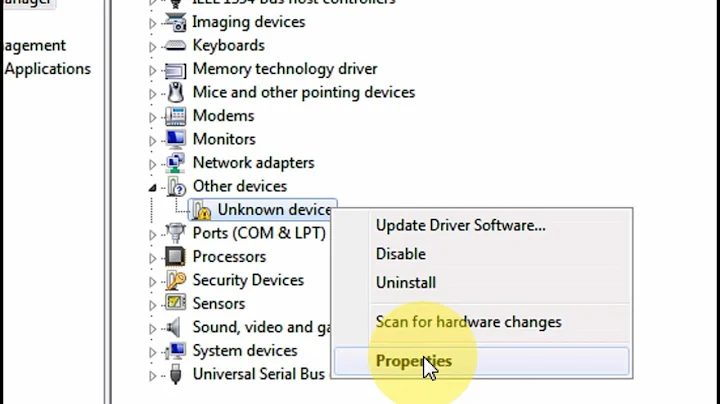Why I can't create a hard link from device file in other than /dev directory?
Solution 1
But I could only create a hard link in the /dev directory and it was not possible in other directories.
As shown by the error message, it is not possible to create a hard link across different filesystems; you can create only soft (symbolic) links.
For instance, if your /home is in a different partition than your root partition, you won't be able to hard link /tmp/foo to /home/user/.
Now, as @RichardNeumann pointed out, /dev is usually mounted as a devtmpfs filesystem. See this example:
[dr01@centos7 ~]$ df
Filesystem 1K-blocks Used Available Use% Mounted on
/dev/mapper/centos_centos7-root 46110724 3792836 42317888 9% /
devtmpfs 4063180 0 4063180 0% /dev
tmpfs 4078924 0 4078924 0% /dev/shm
tmpfs 4078924 9148 4069776 1% /run
tmpfs 4078924 0 4078924 0% /sys/fs/cgroup
/dev/sda1 1038336 202684 835652 20% /boot
tmpfs 815788 28 815760 1% /run/user/1000
Therefore you can only create hard links to files in /dev within /dev.
Solution 2
A hard link cannot be used to achieve what you want, because hard links do not work between file systems.
However, you can achieve what you want with the mknod command.
Run
ls -l /dev/devicefile. You should see an output like this:crw-rw-rw- 1 root root 1, 9 Mar 29 15:46 /dev/urandom- Take note of the number in the size column (
1, 9). - Run the command
mknod /path/to/destination c 1 9(substituting the values you want).
Why does this work?
Device files are effectively hard links to an abstract file implemented by the kernel or kernel drivers. Whilst you can't create hard links to file system objects from another file system, these aren't file system objects and so, by knowing their major and minor reference numbers, you can create a reference to them from any file system.
Solution 3
Hard links just create another entry in a directory, pointing to a file (where file is a file like thing, such as a directory). Therefore hard-links can not reference a file in another file-system.
Soft-links are you friend in this case. Use ln -s. Softlinks can go across filesystems, and can even point to something that is not there.
Related videos on Youtube
the_darkside
Updated on September 18, 2022Comments
-
the_darkside almost 2 years
I have a dataframe
testDatawhich is made up of many unique ids. My objective is to identify whether or not the ids contain all of the numbers in the range ofmonth,yday, andweekIn other words, if
idhas all possible values in the range inmonth, then it should receive at. Ifidhas all possible values in the range inyday, it should receive at, and ifidhas all possible values in the range inweek, it should receive at. Otherwise, it should receive anfA sample of the data looks like this:
> testData id month yday week 1 1 1 1 1 2 3 1 2 1 3 4 1 3 1 4 2 1 4 1 5 3 3 5 1 6 4 1 6 1 7 2 1 7 1 8 3 1 8 2 9 1 1 9 2 10 5 1 10 2 11 3 2 11 1 12 4 1 12 1 13 5 1 13 1 14 1 1 14 1The output should look something like this:
> output id month yday week 1 1 f f t 2 2 f f f 3 3 t f t 4 4 f f f 5 5 f f tI know that one can check if a numbers are within a certain range with
findInterval(), but could someone suggest a method to check if numbers in a vector contain all integers within a range?> dput(testData) structure(list(id = c(1L, 3L, 4L, 2L, 3L, 4L, 2L, 3L, 1L, 5L, 3L, 4L, 5L, 1L), month = c(1L, 1L, 1L, 1L, 3L, 1L, 1L, 1L, 1L, 1L, 2L, 1L, 1L, 1L), yday = 1:14, week = c(1L, 1L, 1L, 1L, 1L, 1L, 1L, 2L, 2L, 2L, 1L, 1L, 1L, 1L)), .Names = c("id", "month", "yday", "week"), class = "data.frame", row.names = c(NA, -14L )) -
nicola about 7 yearsDidn't see your answer when posting mine. Guess mine is more general and can adapt to a bigger number of columns. Feel free to edit to include my
Mapway of dealing with all the columns and I will delete my answer. -
Richard Neumann about 6 yearsThe partition is not the issue. It is, as you stated the cross-filesystem limitation.
/devis usually mounted as adevtmpfsfilesystem. Thus you can only create hardlinks to files in/devwithin/dev. You e.g. cannot even create hardlinks to/dev/nullwithin/dev/pts, because it is mounted withdevptsas a different file system. -
 dr_ about 6 years@RichardNeumann Good point. I corrected my answer which was only partly correct.
dr_ about 6 years@RichardNeumann Good point. I corrected my answer which was only partly correct.


![How to Change iTunes Backup Location in Windows 10! [Complete Guide]](https://i.ytimg.com/vi/adfH2Q8WpKo/hq720.jpg?sqp=-oaymwEcCNAFEJQDSFXyq4qpAw4IARUAAIhCGAFwAcABBg==&rs=AOn4CLAPj63I7b2BepyUdynGOodNMAGpTA)

